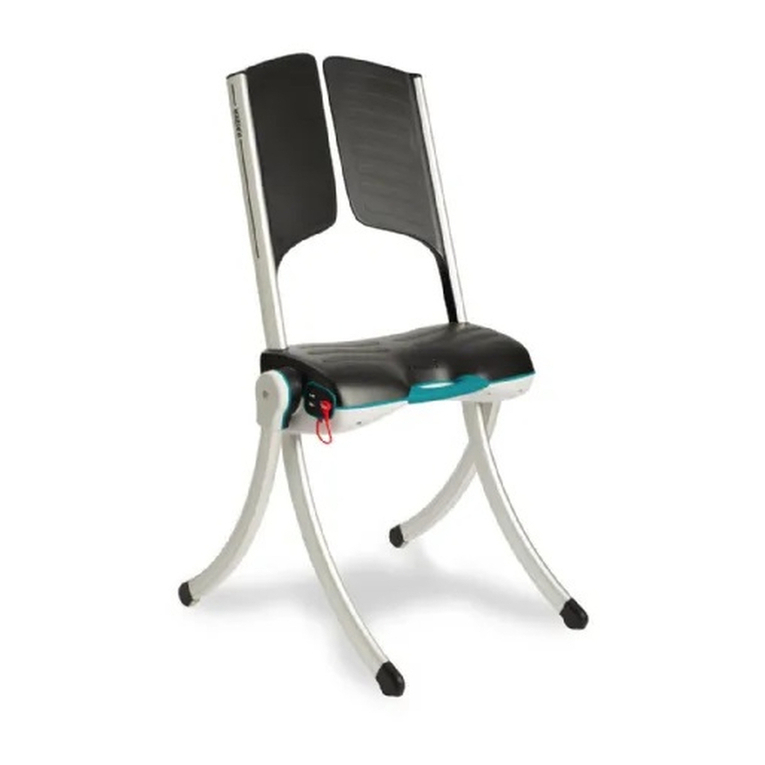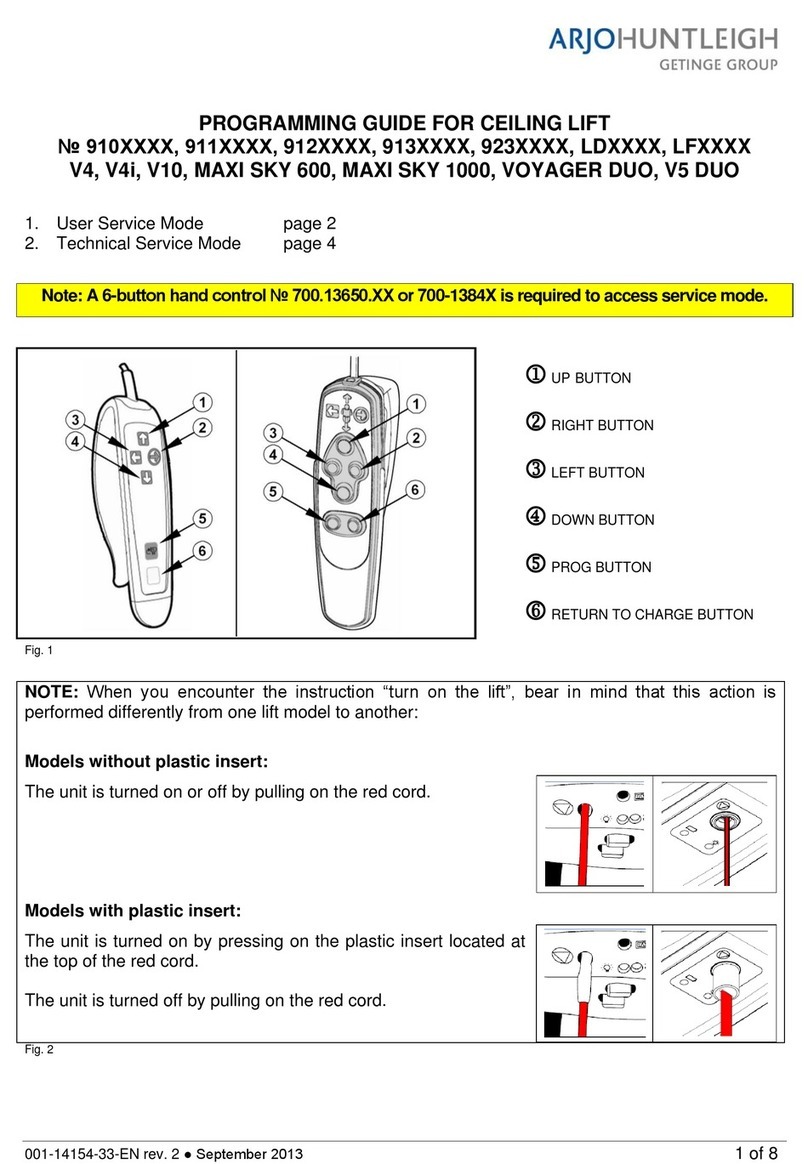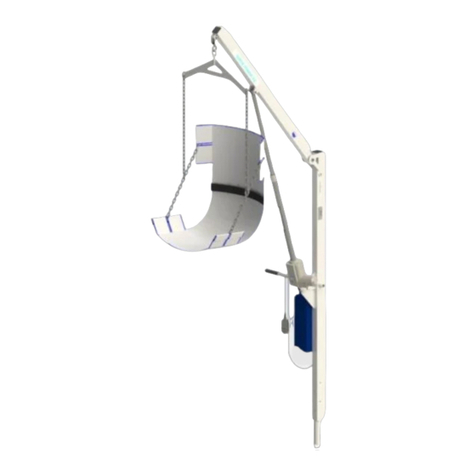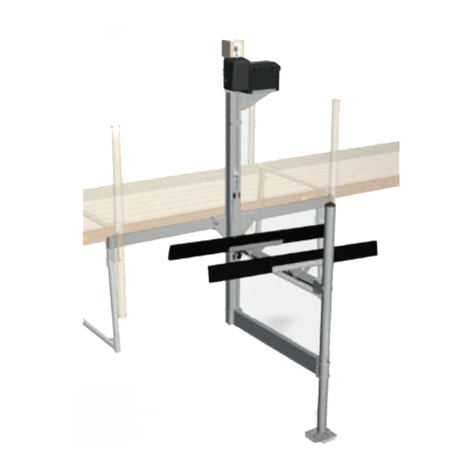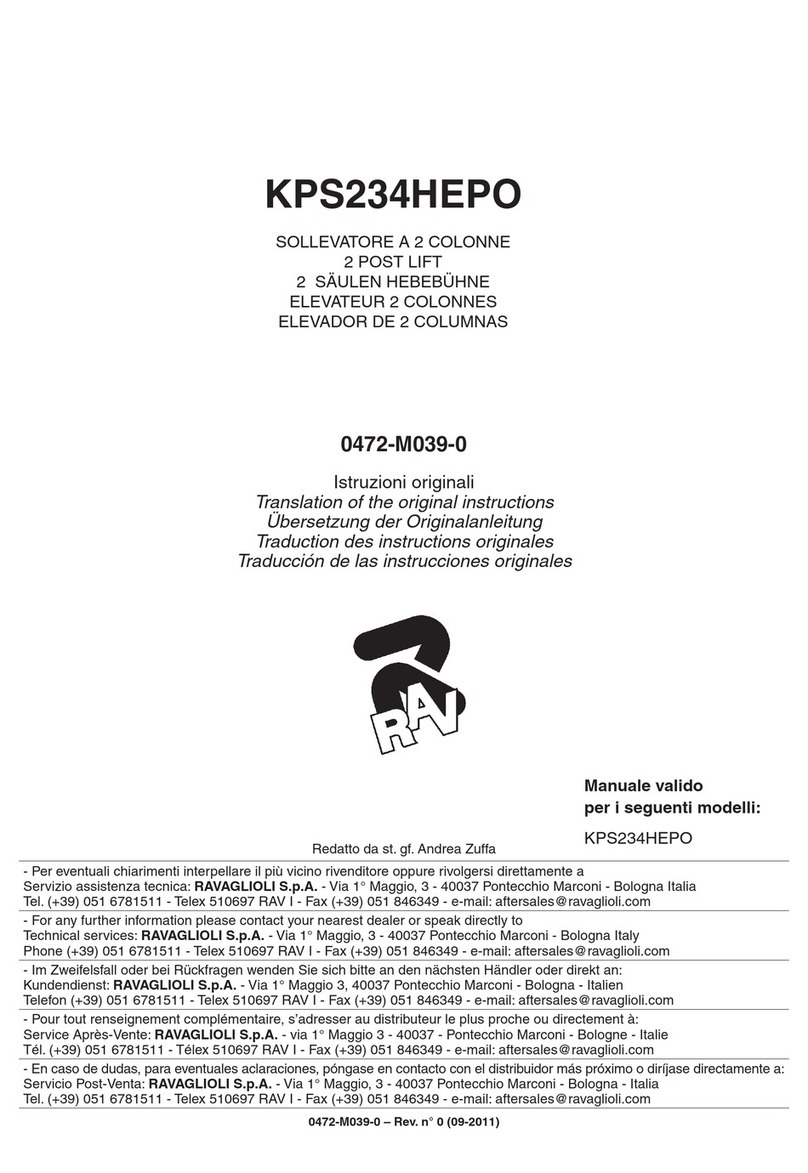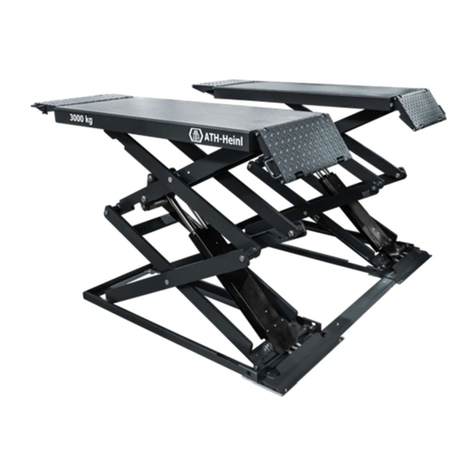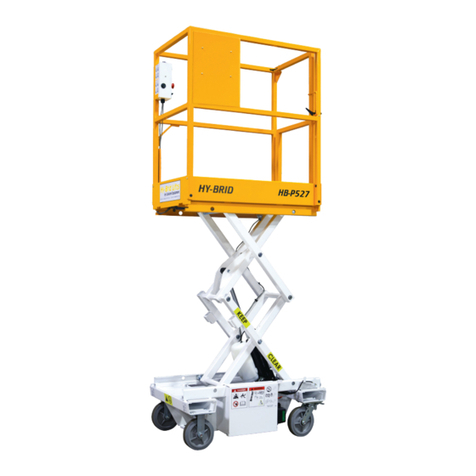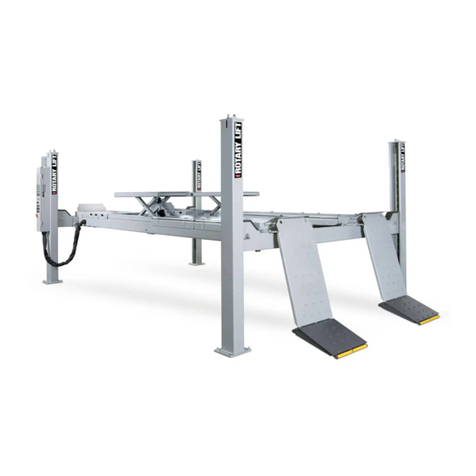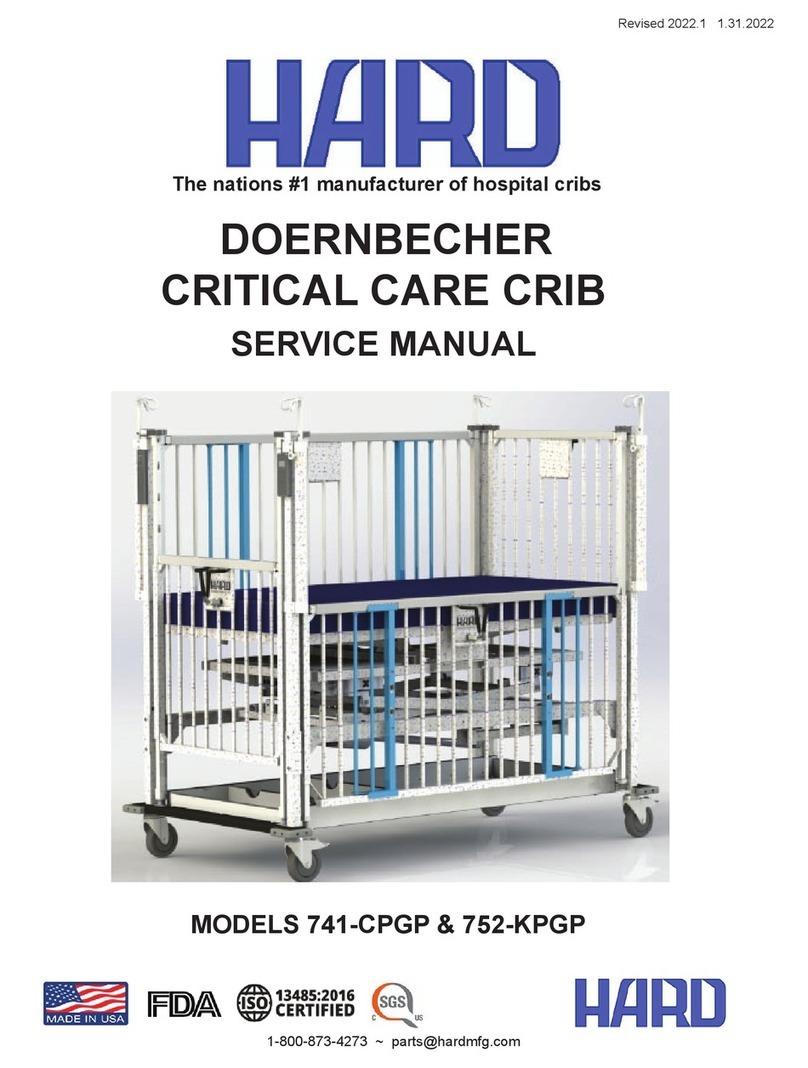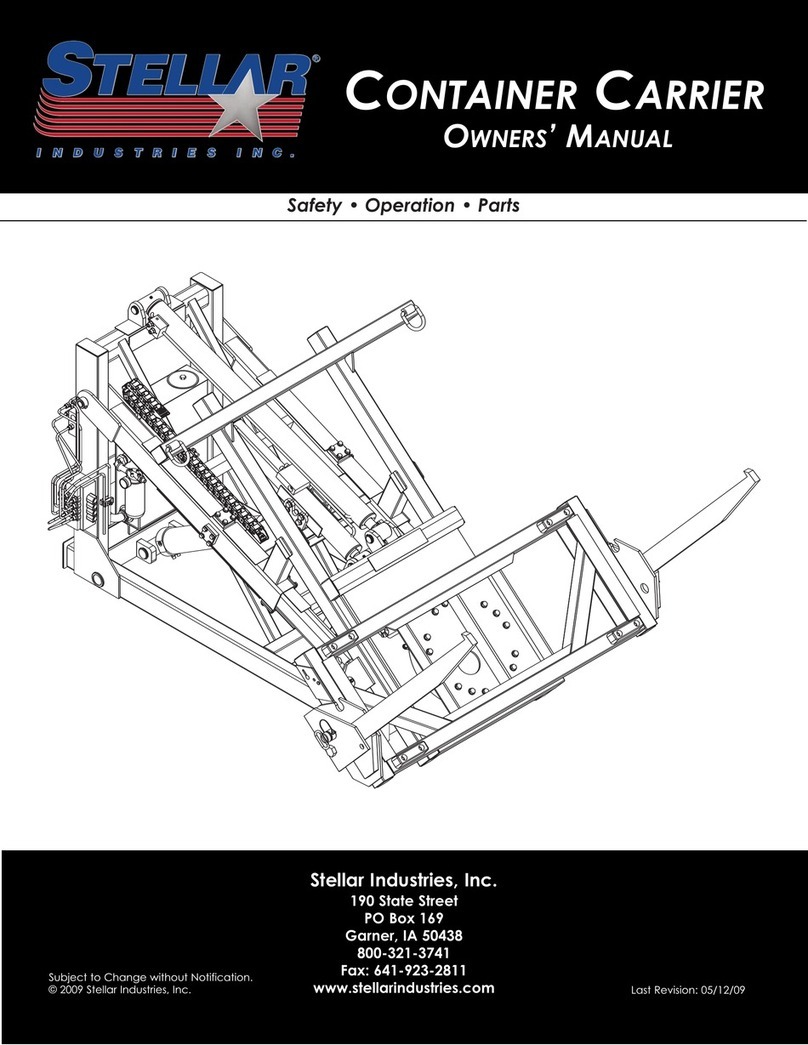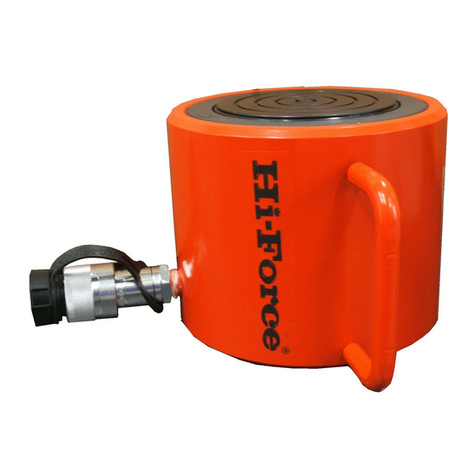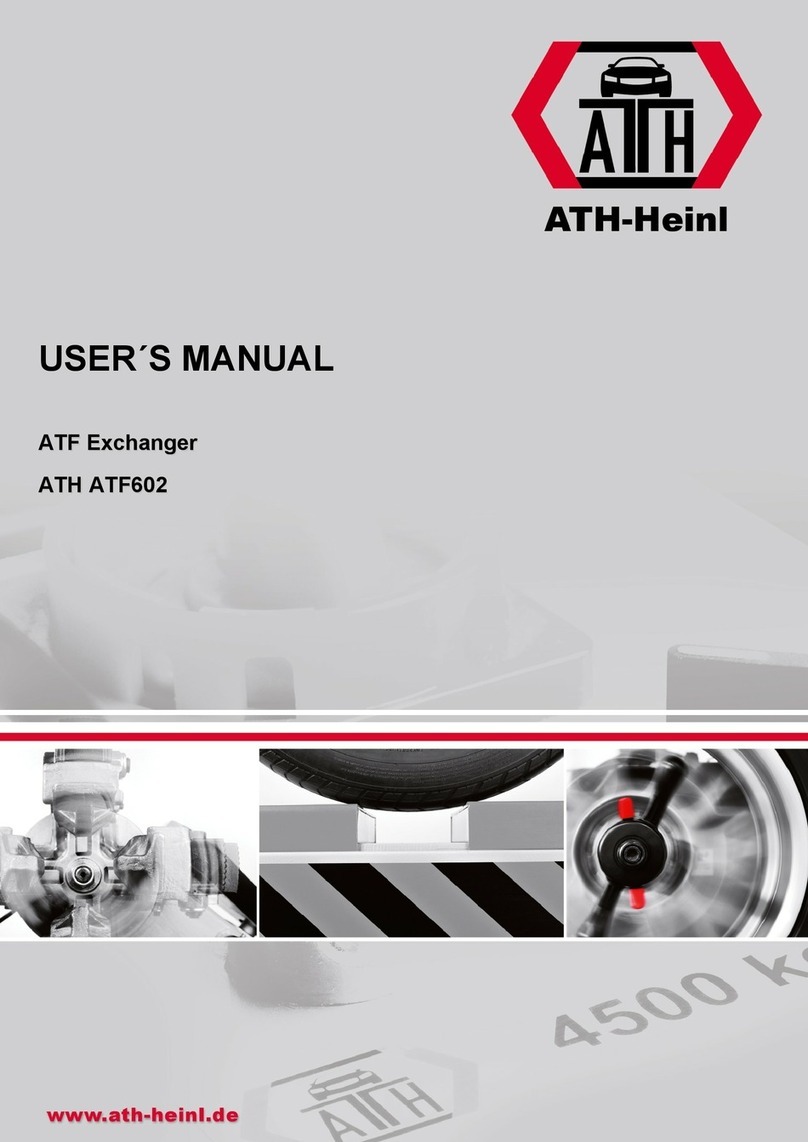Bosch VLS 3130 User manual

VLS 3130
de
Originalbetriebsanleitung
Kurzhubscheren-Hebebühne
en
Original instructions
Short-stroke scissor lifting platform
fr
Notice originale
Pont élévateur à ciseaux à course
courte
es
Manual original
Plataforma elevadora de tijera de
carrera corta
it
Istruzioni originali
Ponte sollevatore a pantografo a corsa
corta
sv
Bruksanvisning i original
Låglyftande billyft av saxmodell
nl
Oorspronkelijke gebruiksaanwijzing
Hefplatform met korte hefscharen
pt
Manual original
Plataforma elevatória tipo tesoura de
pequeno curso
pl
Instrukcją oryginalną
cs
Původní návod k používání
tr
Orijinal işletme talimatı
zh
原始的指南
Podnośnik krótkonożycowy
Nízkozdvižná nůžková zvedací plošina Kısa Kaldırma Makaslı Oto Lifti 短行程剪式升降台

1 689 989 106 2012-09-10| Robert Bosch GmbH
20 | VLS 3130 |en
Contents
1. Symbols used 21
1.1 In the documentation 21
1.1.1 Warning notices -
Structure and meaning 21
1.1.2 Symbols in this documentation 21
1.2 On the product 21
2. Important notes 22
3. Safety instructions 22
3.1 Mains voltage 22
3.2 Risk of injury, danger of crushing 22
4. Company obligations 23
4.1 Operation of lifting platforms 23
4.2 Checking of lifting platforms 23
4.2.1 Scope of checking 23
4.2.2 Regular checking 23
4.2.3 Exceptional checking 23
4.3 Test log book 23
4.4 Inspection log 24
5. Product description 24
5.1 Designated use 24
5.2 Authorized users 25
5.3 Preparation by the user 25
5.3.1 Space requirements 25
5.3.2 Foundation and connections 25
5.4 Transportation information 25
5.5 Set-up and initial commissioning 25
5.6 Scope of delivery 25
5.7 Special accessories 25
5.8 Description of unit 26
5.8.1 Overview 26
5.8.2 Lifting platform 26
5.8.3 Lifting mechanism 26
5.8.4 Access ramps 26
5.8.5 Operating unit 27
5.8.6 Rotary reversing switch 27
5.9 Safety features 27
6. Operation 28
6.1 Essential points for operation 28
6.2 Preparation 28
6.3 Vehicle positioning 28
6.4 Lifting the vehicle 29
6.5 During work on vehicle 29
6.6 Lowering the vehicle 30
6.7 Driving the vehicle off 30
6.8 Deactivation 30
7. Using the mobile set 31
8. Note on troubleshooting 32
9. Maintenance 33
9.1 Important notes on maintenance 33
9.2 Emergency lowering 33
9.3 Cleaning 33
9.4 Spare and wearing parts 33
9.5 Maintenance by the user 33
9.5.1 Maintenance agreement 33
9.5.2 Maintenance schedule 34
10. Decommissioning 34
10.1 Temporary shutdown 34
10.2 Change of location 34
10.3 Disposal and scrapping 34
10.3.1 Substances hazardous to water 34
10.3.2 VLS 3130 and accessories 34
11. Technical data 35
11.1 Ambient conditions 35
11.1.1 Operation 35
11.1.2 Storage and transport 35
11.2 Performance data 35
11.3 Operating data 35
11.3.1 Electric current 35
11.3.2 Hydraulic 35
11.4 Electromagnetic compatibility (EMC) 35
11.5 Noise emissions 35
11.6 Dimensions and weight 35

1 689 989 106 2012-09-10|Robert Bosch GmbH
Symbols used | VLS 3130 | 21 en
1. Symbols used
1.1 In the documentation
1.1.1 Warning notices - Structure and meaning
Warning notices warn of dangers to the user or people
in the vicinity. Warning notices also indicate the
consequences of the hazard as well as preventive action.
Warning notices have the following structure:
Warning
symbol
KEY WORD – Nature and source of hazard!
Consequences of hazard in the event of
failure to observe action and information
given.
Hazard prevention action and information.
The key word indicates the likelihood of occurrence and
the severity of the hazard in the event of non-observance:
Key word Probability of
occurrence
Severity of danger if
instructions not observed
DANGER Immediate impending
danger
Death or severe injury
WARNING Possible impending
danger
Death or severe injury
CAUTION Possible dangerous
situation
Minor injury
1.1.2 Symbols in this documentation
Symbol Designation Explanation
!Attention Warns about possible property damage.
iInformation Practical hints and other
useful information.
1.
2.
Multi-step
operation
Instruction consisting of several steps.
eOne-step
operation
Instruction consisting of one step.
Intermediate
result
An instruction produces a visible
intermediate result.
"Final result There is a visible final result on
completion of the instruction.
DANGER – Exposure of live parts on
opening the VLS 3130!
Risk of (fatal) injury or heart failure
from electric shocks on contact with live
components (e.g. master switch, printed
circuit boards).
Work on electrical installations or
equipment is only to be performed by
qualified electricians or trained personnel
under the guidance and supervision of an
electrician.
Disconnect the VLS 3130 from the mains
before opening.
Disposal
Dispose of used electrical and electronic
devices, including cables, accessories and
batteries, separately from household waste.
1.2 On the product
!Observe all warning notices on products and ensure
they remain legible.
The transporting of persons on the lifting
tables or in the vehicle is prohibited.
Notes on load distribution
The load center must be within the designated area.
Quick user guide
Safety instructions
Operation
Controls
Maintenance work
Load distribution
Approach direction

1 689 989 106 2012-09-10| Robert Bosch GmbH
22 | VLS 3130 | Important notesen
2. Important notes
Before start up, connecting and operating
Bosch products it is absolutely
essential that the operating instructions/
owner’s manual and, in particular, the
safety instructions are studied carefully. By doing so
you can eliminate any uncertainties in handling
Bosch products and thus associated safety risks
upfront; something which is in the interests of your own
safety and will ultimately help avoid damage to the
device. When a Bosch product is handed over to
another person, not only the operating instructions but
also the safety instructions and information on its
designated use must be handed over to the person.
3. Safety instructions
3.1 Mains voltage
Insulation damage and other faults may result
in accessible components being live.
Safety measures:
Only ever use the power cord provided or a tested
power cord.
Replace wires with damaged insulation.
Do not open the operating unit.
3.2 Risk of injury, danger of crushing
In the event of excessive vehicle weight,
incorrect mounting of the vehicle or on removing
heavy objects, there is a risk of the vehicle falling
off the lifting platform or tipping up.
Safety measures:
The lifting platform is only ever to be employed for
the intended purpose.
Carefully study and heed all the information given in
Section 6.1.
Observe the warning notices for operation (Section 6).
Use of the product constitutes acceptance of the
following conditions:
Copyright
The enclosed instructions are the property of
Robert Bosch GmbH or its suppliers and are protected
against reproduction by copyright laws, international
agreements and other national legal stipulations. The
reproduction or disposal of instructions or excerpts
thereof is impermissible and constitutes an offence. In
the event of contravention, Robert Bosch GmbH reserves
the right to take legal action and assert claims for
damages.
Warranty
The use of non-approved hardware causes changes to
our products and thus results in the exclusion of any
liability and warranty claims, even if the hardware has
been removed again in the meantime.
It is not permissible to make any changes to our
products and these are only to be used together with
genuine accessories and genuine replacement parts.
Otherwise any warranty claims will be invalid.
Liability
Liability on the part of Robert Bosch GmbH is limited
to the amount actually paid by the customer for the
product concerned. This exemption from liability does
not apply to wilful damage or damage arising from
gross negligence on the part of Robert Bosch GmbH.

1 689 989 106 2012-09-10|Robert Bosch GmbH
Company obligations | VLS 3130 | 23 en
4. Company obligations
4.1 Operation of lifting platforms
In Germany, the use of lifting platforms is governed
by the mandatory "Employers' liability insurance
association regulations on health and work safety
as defined in BGR 500 Section 2.10". In all other
countries, the applicable national regulations, laws and
directives must be observed.
4.2 Checking of lifting platforms
Checking is to be based on
The basic principles for testing lifting platforms
(BGG 45)
The basic health and safety requirements stipulated
in the directive 2006/42/EC
The harmonized European Standards
The generally acknowledged rules of engineering
The directive on the use of equipment 89/655/EEC
The applicable accident prevention regulations
The checks are to be organized by the user of the
lifting platform. The user is responsible for appointing
an expert or qualified person to perform checking. It
must be ensured that the person chosen satisfies the
requirements of BGG 945 as per Section 3.
!The user bears special responsibility if employees
of the company are appointed as expert or qualified
person.
4.2.1 Scope of checking
Regular checking essentially involves performing visual
inspection and a functional test. This includes checking
the condition of the components and equipment,
checking that the safety systems are complete and
functioning properly and that the test log book is
completely filled in.
The scope of exceptional checking depends on the
nature and extent of any structural modification or
repair work.
4.2.2 Regular checking
After initial commissioning, lifting platforms are to be
checked by a qualified person at intervals of not longer
than one year.
A qualified person is somebody with the training and
experience required to possess sufficient knowledge
of lifting platforms and who is familiar enough with
the pertinent national regulations, accident prevention
regulations and generally acknowledged rules of
engineering (e.g. BG rules, DIN Standards, VDE
provisions, the technical regulations of other European
Union member states or other parties to the agreement
on the European economic area) to be able to assess
the safe operating condition of lifting platforms.
4.2.3 Exceptional checking
Lifting platforms with a lift height of more than 2
meters and lifting platforms intended for use with
people standing under the loadbearing elements or
the load are to be checked by an expert prior to re-use
following structural modifications and major repairs to
loadbearing components.
An expert is somebody with the training and experience
required to possess specialist knowledge of lifting
platforms and who is familiar enough with the
pertinent national work safety regulations, accident
prevention regulations and generally acknowledged
rules of engineering (e.g. BG rules, DIN Standards, VDE
provisions, the technical regulations of other European
Union member states or other parties to the agreement
on the European economic area) to be able to check
and give an expert opinion on lifting platforms.
4.3 Test log book
A test log book is to be kept as a record of the lifting
platform checks performed. The test log book must
contain a report on the test performed prior to initial
commissioning and the regular and exceptional checks,
as well as the applicable certification on (EC) type
testing and the EC declaration of conformity.
The report must include:
The date and scope of testing with details of any test
items not yet performed
The results of the test with details of any
shortcomings established
An assessment of whether there are any
impediments to start-up or further use
The details of any follow-up testing required
The name, address and signature of the checker
iThe acknowledgement and rectification of any
shortcomings found must be confirmed by the
company in the report.

1 689 989 106 2012-09-10| Robert Bosch GmbH
24 | VLS 3130 | Product descriptionen
4.4 Inspection log
An inspection log is to be kept as a record of the lifting
platform checks performed. The inspection log book
must contain a report on the test performed prior to
initial commissioning and the regular and exceptional
checks, as well as the applicable certification on (EC)
type testing and the EC declaration of conformity.
The report must include:
The date and scope of testing with details of any test
items not yet performed
The results of the test with details of any
shortcomings established
An assessment of whether there are any
impediments to start-up or further use
The details of any follow-up testing required
The name, address and signature of the person
carrying out the checks
iThe acknowledgement and rectification of any
shortcomings found must be confirmed by the plant
operator in the report.
5. Product description
5.1 Designated use
The type-approved lifting platform VLS 3130 is intended
solely for the following use:
Lifting passenger cars or motor vehicles with the aid
of two lifting tables.
The limit values for the lifting platform's load bearing
capacity and load distribution must be observed.
The following regulations must be observed when
starting up and operating lifting platforms:
Rules for lifting platform operation (BGR 500)
Basic principles for testing lifting platforms
(BGG 945)
Rules for keeping the inspection log (BGG 945-A2)
The lifting platform is not to be used as a crane or as
a support for other lifting mechanisms (e.g. block and
tackle).
The lifting platform is designed such that people
can stand under the loadbearing elements. It is not
equipped to permit walking on the lifting platform or
for conveying people.
Erection of the lifting platform is prohibited in
explosion and fire hazard areas, outdoor areas and in
damp atmospheres (e.g. washing shops).
The original operating instructions must be kept in
a conspicuous, constantly accessible location near
the lifting platform. All the above regulations must be
heeded as well as the applicable rules on work safety
and accident prevention.

1 689 989 106 2012-09-10|Robert Bosch GmbH
Product description | VLS 3130 | 25 en
5.2 Authorized users
Only users aged 18 or above who have been instructed
on how to operate the lifting platform and have proven
their ability to do so to the owner are to be entrusted
with unsupervised operation of lifting platforms. The
task of operating the lifting platform must be expressly
assigned to users by the owner. Authorization to
operate lifting platforms must be granted in writing.
Before loading a vehicle onto the lifting platform, users
should study the original operating instructions and
familiarize themselves with the operating procedures in
several trial runs.
5.3 Preparation by the user
5.3.1 Space requirements
Refer to Appendix A for the dimensions of the lifting
platform.
There must also be a clearance of at least 1 meter
between the lifting platform and fixed elements
(e.g. wall) in all lifting positions.
There must be sufficient space at the ends of the lifting
platform for driving vehicles on and off.
iTo stop vehicles colliding with the ceiling, it is
advisable to fit an overhead light barrier in low-
ceilinged buildings.
5.3.2 Foundation and connections
The user must have the following work performed
before erecting the platform:
Construction of the foundation following
consultation with Bosch customer service or an
authorized service agent.
Routing of the wiring to the installation location.
The user must provide fuse protection for the
connection.
Routing of the compressed air connection to the
installation location. The user must install a service
unit upstream of the connection.
iRefer also to the corresponding information in the
commissioning instructions.
5.4 Transportation information
The lifting platform is delivered as follows:
Packing unit Dimensions Weight
1 x pallet 1820 x 1545 x 450 mm
(6.0 x 5.0 x 1.5 feet)
750 kg
(992 lb)
The user must provide a forklift truck for internal
transport. The center of gravity and lashing points are
marked on the packaging.
X
Fig. 1: Center of gravity of packaging (example)
5.5 Set-up and initial commissioning
The lifting platform is only to be started up by Bosch
customer service or an authorized service agent. Initial
commissioning of the lifting platform is described in the
installation instructions. Acceptance must be performed
by a qualified person after initial commissioning.
5.6 Scope of delivery
Description Order no.
Lifting platform VLS 3130, complete 1 692 852 301
20 mm elastomer retainers (x 4) 1 692 872 361
Original instructions 1 689 989 106
Test log book 1 689 977 092
5.7 Special accessories
Description Order no.
Mobile set (1 draw bar, 2 running rollers) 1 692 871 301
Information on additional special accessories is
available from your authorized Bosch dealer.

1 689 989 106 2012-09-10| Robert Bosch GmbH
26 | VLS 3130 | Product descriptionen
5.8 Description of unit
5.8.1 Overview
VLS 3130 is a short-stroke scissor lifting platform
with electro-hydraulic drive. Fig. 2 shows the principal
components.
Fig. 2: Components
1 Lifting platform
2 Operating unit with hydraulic unit
3 Connecting cable
5.8.2 Lifting platform
Fig. 3: Lifting platform
1 Access ramp
2 Lifting table
3 Scissor mechanism
4 Hydraulic cylinders
5 "Foot protection" safety switch
6 Front transverse bar (fixed bearing)
7 Rear transverse bar (loose bearing)
8 Slider
9 Base plate
The lifting platform is mounted on a two-part
base plate 9). Each base plate features a scissor
mechanism (3), which can be raised and lowered via
hydraulic cylinders (4). Each scissor mechanism carries
a lifting table (2), which acts as the load-bearing
element.
5.8.3 Lifting mechanism
Two hydraulic cylinders are attached to each scissor
strut. When the hydraulic cylinders extend, the scissors
move up, thereby raising the lifting table.
The synchronized movement of both sides is ensured
as follows:
The scissor struts on both sides are connected by
transverse bars (5, 6).
The two hydraulic cylinders of each scissor strut
are powered by separate hydraulic circuits. The
hydraulic cylinders in a circuit are connected in
parallel. See Fig. 4.
Fig. 4: Hydraulic synchronization control
P1, P2 Hydraulic cylinders
A, B Hydraulic circuits
5.8.4 Access ramps
Fig. 5: Access ramp
1 Stop lever
The access ramps help the vehicle to drive on and off
the lifting table. If required, the access ramps can be
folded up and locked in place to extend the lifting table.

1 689 989 106 2012-09-10|Robert Bosch GmbH
Product description | VLS 3130 | 27 en
5.8.5 Operating unit
Fig. 6: Operating unit
1 Rotary reversing switch
2 "Foot protection" confirmation button
3 Acoustic signal generator
4 Hydraulic unit
5 Oil tank
6 Leads connecting to lifting platform
5.8.6 Rotary reversing switch
Lockable rotary reversing switch with emergency stop
function. The rotary reversing switch has three settings:
Setting Function
OOff/emergency stop
Lifting platform is deactivated. The rotary reversing
switch can be secured with a lock in this position.
oRaising.
The lifting platform moves up as long as the rotary
reversing switch is pressed to the right. Movement is
stopped in the following cases:
Rotary reversing switch is released.
Upper limit value is reached.
uLowering.
The lifting platform moves down as long as the
rotary reversing switch is pressed to the left.
Movement is stopped in the following cases:
Rotary reversing switch is released.
"Foot protection" safety level
(300 mm) is reached.
Lower end position is reached.
Tab. 1: Rotary reversing switch
5.9 Safety features
During assembly and operation, it must be ensured
that all safety devices are fully functional. This must
be verified on a regular basis and after any fault.
The lifting platform must only be maintained
and repaired by Bosch customer service or
an authorized service agent with appropriate
certification.
Always use genuine replacement parts. The
installation of parts from other manufacturers will
render the type approval and any warranty claims
invalid.
In particular, the functioning of the following safety
devices must be checked after any fault.
Safety feature Function
EMERGENCY
STOP function
Via the lockable yellow and red rotary
reversing switch.
Deadman
control
The lifting (o) and lowering (u) functions are
only active while the rotary reversing switch
is held in the relevant position.
Foot protection
function
Lowering of the lifting platform is stopped
automatically at a height of 300 mm ("foot
protection" safety level). In this case,
release the rotary reversing switch and
check the area under the lifting platform. If
it is safe to do so, press and hold the "foot
protection" confirmation button and turn
the rotary reversing switch to "lowering"
again. A warning signal sounds and the lifting
platform continues to move downward until
the lower end position is reached.
Synchronization
control
The synchronization of the two scissor
mechanisms is ensured by two transverse
bars and a dual-redundant hydraulic system.
Overload
protection for
drive motor
The drive motor is protected by a
temperature sensor. Following an overload,
the lifting platform can be operated again
after a cooling time of 10 minutes.
Tab. 2: Safety features

1 689 989 106 2012-09-10| Robert Bosch GmbH
28 | VLS 3130 | Operationen
6. Operation
6.1 Essential points for operation
Only authorized, trained personnel aged 18 years or
older are permitted to operate the lifting platform.
Only passenger cars or motor vehicles with a
maximum overall weight of 3000 kg may be lifted.
In the case of maximum load, the front/rear load
distribution must not exceed 3 : 2.
Certain special-purpose vehicles must not be raised
using scissor lifting platforms. Before lifting any
vehicle, you must establish whether it is such a
special-purpose vehicle.
Lift vehicles only by the four lifting points specified
by the vehicle manufacturer.
The lifting platform must only be operated via the
supplied operating unit.
Before moving the lifting platform, make sure that
there are no persons within the danger zone, and
that that no objects are leaning against or positioned
on the vehicle or lifting platform.
No unauthorized personnel must be allowed in the
vicinity of the lifting platform.
Riding on the lifting platform or in the raised vehicle
is prohibited.
Do not use the lifting platform as a crane or a
support for other lifting mechanisms (e.g. pulley).
Electric welding work on the raised vehicle or on the
lifting platform itself is only permitted if the master
switch is turned to OFF (O).
Never use the lifting platform in the event of
malfunction or component damage.
If the lifting platform malfunctions, shut it down
immediately, secure it against unauthorized use and
notify Bosch customer service or an authorized
service outlet.
Lock the rotary reversing switch when the lifting
platform is not in use.
6.2 Preparation
1. Make sure that the lifting platform is connected to
the power supply.
2. Make sure that the lifting platform is fully lowered.
3. Make sure that the access ramps are fully lowered.
4. Remove any tools, dirt, grease and oil from the lifting
platform and the area around it.
"The vehicle can now be driven onto the lifting platform.
6.3 Vehicle positioning
DANGER – Incorrect positioning of vehicle!
Risk of (fatal) injury due to the vehicle falling
or tipping during lifting or lowering and when
working on the vehicle.
Position the vehicle exactly as described
here.
1. Make sure that the lifting platform is fully lowered.
2. Make sure that the access ramps are fully lowered.
3. Drive the vehicle over the lifting tables centrally and
in a straight line.
!Ensure the correct vehicle approach: The front of the
vehicle must be above the hydraulic cylinders!
4. Drive the vehicle forward until its center of gravity is
within the specified area.
iThe center of gravity of many vehicles is around the
area of the front door hinges.
5. Apply the locking brake and turn off the engine.
6. Exit the vehicle.
"Vehicle is positioned above the lifting tables.

1 689 989 106 2012-09-10|Robert Bosch GmbH
Operation | VLS 3130 | 29 en
6.4 Lifting the vehicle
DANGER – Risk of vehicle falling or tipping!
Risk of (fatal) injury when lifting (or raising) the
lifting platform.
Make sure that the vehicle is correctly
positioned over the lifting tables.
Make sure that there are no persons in
the vehicle or in the vicinity of the lifting
platform.
Keep a safe distance from the lifting
platform.
Observe the lifting platform, the lifting
points and the vehicle.
1. Check the condition of the lifting points defined by
the vehicle manufacturer, specifically for corrosion
and stability.
2. Position the elastomer retainers under the vehicle
lifting points.
iIf the lifting table is too short for the prescribed
lifting points, fold up the access ramps to extend the
lifting tables.
3. Turn the rotary reversing switch to "raising" (o) and
hold it in this position.
The lifting tables move upward as long as the
button is pressed.
4. Raise the vehicle until its tires are off the ground.
5. Stop the lifting table and check that the elastomer
retainers are firmly affixed to the lifting points.
iIf the vehicle is not stable, lower the lifting platform
and reposition the vehicle before raising it again.
6. Continue raising the vehicle after ensuring its
stability.
7. Raise the lifting platform to the desired height or
until the upper end position is reached and then
release the rotary reversing switch.
"The lifting platform and vehicle have now been raised.
6.5 During work on vehicle
DANGER – Risk of vehicle falling or tipping!
Risk of (fatal) injury whilst using lifting platform.
Do not approach the vehicle unless all four
elastomer retainers are firmly affixed to
the lifting points specified by the vehicle
manufacturer.
Avoid subjecting the vehicle to severe
vibration or jolting.
Never cause the vehicle or lifting platform
to vibrate.
Always use safety devices when removing or
attaching heavy components (e.g. engine,
transmission). Fit the safety devices such
that they reach the vehicle, rather than
lowering the vehicle onto the safety devices.

1 689 989 106 2012-09-10| Robert Bosch GmbH
30 | VLS 3130 | Operationen
6.6 Lowering the vehicle
DANGER – Risk of vehicle falling or tipping!
Risk of (fatal) injury when lowering the support
arms and the vehicle.
Ensure that the elastomer retainers are
firmly affixed to the lifting points.
Avoid jerky movements of the vehicle and
lifting platform.
DANGER – Risk of crushing when lowering
the lifting platform!
Risk of (fatal) injury when lowering the lifting
platform.
Make sure that there are no persons in
the vehicle or in the vicinity of the lifting
platform.
Ensure that there are no objects in the
vicinity of the lifting platform.
Keep a safe distance from the lifting
platform.
1. Remove unsecured tools and other objects from the
vehicle and the lifting platform.
2. Turn the rotary reversing switch to "lowering" (u)
and hold it in this position.
The lifting tables move downward as long as the
button is pressed.
Lowering of the running rail is stopped
automatically at a height of 300 mm ("foot
protection" safety level).
3. Check the area beneath the running rail.
4. If it is safe to do so, press and hold the "foot
protection" confirmation button.
5. Turn the rotary reversing switch to "lowering" (u)
again and hold it in this position.
A warning signal sounds and the lifting platform
moves down to its lowest position.
"The lifting platform and vehicle are now fully
lowered.
6.7 Driving the vehicle off
1. Make sure that the lifting platform is fully lowered.
2. Remove the elastomer retainers.
3. Lower the access ramps.
4. Ensure that the exit area is unobstructed.
5. Drive the vehicle off the lifting tables in a straight
line.
"The lifting platform is now empty.
6.8 Deactivation
1. Use a padlock to secure the rotary reversing switch
in the OFF position (O).
"The lifting platform is deactivated and locked.

1 689 989 106 2012-09-10|Robert Bosch GmbH
Using the mobile set | VLS 3130 | 31 en
7. Using the mobile set
The mobile set is available as a special accessory. It
allows the VLS 3130 to be transported across short
distances (e.g. in a workshop).
The mobile set consists of a draw bar and two
attachable running rollers.
!Requirements for transport via mobile set:
$Lifting platform is not anchored.
$Ground is even.
$Ground is smooth and firm.
DANGER – falling lifting platform!
Risk of crushing in event of incorrect transport
of lifting platform using mobile set.
Ensure that there are no persons or objects
in the vicinity of the lifting platform.
Never reach underneath the base plate of
the lifting platform!
Avoid jerky movements when transporting
the lifting platform on the running rollers.
Fitting the running rollers
1. Raise the empty lifting platform by approx. 50 cm.
2. Attach the running rollers to the front transverse bar
(fixed bearing) and secure with bolts.
Fig. 7: Fitting the mobile set
1 Attachable running rollers
2 Attachment point for draw bar
3 Draw bar with wheels
3. Fully lower the lifting platform.
The rotation of the front transverse bar presses
the running rollers onto the ground.
The front end of the lifting platform rests on the
running rollers.
Fig. 8: Attachable running roller after lowering of lifting
platform
Transporting the lifting platform
1. Disconnect the mains plug of the operating unit.
2. Place the operating unit on the lifting table.
!Ensure that the operating unit cannot fall during
transport.
3. Affix the bolt of the draw bar to the attachment
point on the front transverse bar.
4. Push the draw bar handle down to raise the lifting
platform.
5. Ensure that there are no persons or objects in the
vicinity of the lifting platform.
6. Use the draw bar to move the lifting platform to
the desired location.
7. Set down the lifting platform and remove the
draw bar.
Removing the running rollers
1. Set up the operating unit at the new location.
2. Connect the mains plug of the operating unit.
3. Raise the empty lifting platform by approx. 50 cm.
4. Remove the bolts and detach the attachable
running rollers.
5. Fully lower the lifting platform.
"The lifting platform is ready for operation again.

1 689 989 106 2012-09-10| Robert Bosch GmbH
32 | VLS 3130 | Note on troubleshootingen
8. Note on troubleshooting
!Should any faults occur which are not listed below, immediately de-energize the lifting platform, shut it down,
secure it against unauthorized use and inform Bosch customer service or an authorized service agent.
!All repair work must be performed by Bosch customer service or an authorized service agent. Only genuine
Bosch replacement parts may be used. Using parts from other manufacturers will render the type approval
invalid.
Fault Possible cause Remedy
No motor operation. Power failure.
Motor overheating,
thermoswitch in motor
has cut out.
Fuses defective.
Control electronics defective.
Check the power supply.
Wait 10 minutes and try again.
Request customer service.
Motor running but lifting platform
cannot be raised.
Vehicle too heavy.
Upper end position reached.
Lack of oil.
Manual lowering valve open.
Hydraulic system defective.
Check whether the permissible load-bearing capacity
of the lifting platform has been exceeded.
Check the oil level.
Manually close the lowering valve.
Request customer service.
Lifting platform raises very slowly. Vehicle too heavy.
Intake filter blocked.
Hydraulic system defective.
Check whether the permissible load-bearing capacity
of the lifting platform has been exceeded.
Clean intake filter (service personnel).
Request customer service.
Lifting platform lowers too slowly. No vehicle on lifting platform. Lower lifting platform manually.
Lifting platform lowers too slowly,
vehicle is on lifting platform.
Fault in hydraulic system. Call in customer service.
Lifting platform does not lower at
all.
Hydraulic system defective.
Power failure.
Call in customer service.
Refer to Section 9.2 Emergency lowering.
Lifting platform does not
lower fully.
"Foot protection" safety level
(300 mm) reached.
Press and hold the "foot protection" confirmation
button and fully lower the lifting platform
using the rotary reversing switch.
Noise during lifting or lowering. Incorrect hydraulic fluid with
insufficient lubrication.
Inadequate lubrication of
scissor sliding surfaces.
Check the oil type.
(Use hydraulic fluid in accordance with ISO 6743/4!)
Lubricate the sliding surfaces.
Request customer service.

1 689 989 106 2012-09-10|Robert Bosch GmbH
Maintenance | VLS 3130 | 33 en
9. Maintenance
!Work on electrical equipment is only to be
performed by persons with sufficient knowledge and
experience of electrical systems.
9.1 Important notes on maintenance
!Before starting maintenance work under raised
lifting platform components, these must be secured
to prevent unintentional movement.
!In the event of breakage of a load-bearing
component, the load-bearing structures and drive
system, including the safety devices, must be
checked to prevent falling or lowering of the load-
bearing element. Damaged parts must be replaced.
9.2 Emergency lowering
!Emergency lowering must only be performed by
specially trained personnel!
!Make sure that no persons or objects are in the
danger area, and use a second person to monitor the
area!
1. Open the front panel of the control console.
2. Remove the screw caps on valves Y2 and Y3.
3. Simultaneously turn the knurled nuts on Y2 and Y3 in
a counter-clockwise direction.
4. The lifting platform lowers.
5. After the lowering procedure, close the knurled nuts
on valves Y2 and Y3 (in a clockwise direction).
6. Mount the screw caps on valves Y2 and Y3.
7. Mount the front panel on to the control console.
9.3 Cleaning
!The lifting platform safety devices are not to be
replaced or bypassed during cleaning.
!Always raise the lifting platform when cleaning the
floor area with detergent.
9.4 Spare and wearing parts
Item/component Order no.
Access ramp See
spare parts list
Hydraulic fluid
20 mm elastomer retainers (x 4) 1 692 872 361
60 mm elastomer retainers (x 4) 1 692 872 362
90 mm elastomer retainers (x 4) 1 692 872 363
9.5 Maintenance by the user
The maintenance work described below must be
performed by the user.
!Prior to maintenance, the platform must always be
disconnected from the mains and secured to prevent
unauthorized use.
!If components are damaged or worn or do not
function properly:
Inform Bosch customer service or an authorized
service agent.
9.5.1 Maintenance agreement
iRegular upkeep of the lifting platform is essential to
ensure a long service life and permanent readiness
for use. We recommend concluding a maintenance
agreement with Bosch customer service or an
authorized service agent.
The lifting platform is only to be cleaned using water
containing a small quantity of neutral or slightly alkaline
detergent. The water temperature must not exceed
25 °C.
The components can be wiped with soft cloths or
sponges. Rinse components with clean water after
cleaning.
!Never use cleaning agents which corrode paintwork,
coatings or sealing materials:
No solvents (esters, ketones, alcohols, halogenated
hydrocarbons)
No abrasive cleaning agents (scouring powder)
No acidic or highly alkaline cleaning agents
!Never clean the lifting platform with high-pressure or
steam cleaners.
iA preservative agent (e.g. commercially available
transparent cavity sealant) provides extra protection
for the coating. This should be applied in all areas
with exposed edges or where moisture may ingress.
This does not apply to the top edge of the runway.

1 689 989 106 2012-09-10| Robert Bosch GmbH
34 | VLS 3130 | Decommissioningen
9.5.2 Maintenance schedule
Daily
Monthly
Half-yearly
Component Activity
x x x Stickers Visual inspection:
All stickers must be present
and clearly legible.
x x x Access ramp Visual inspection:
Components must not be
damaged. Check locking.
x x x Electrical wiring Visual inspection:
No damage to insulation.
x x x Hydraulic system Visual inspection:
No escape of fluid.
x x Exposed surfaces
and edges
Cleaning:
Clean all contaminated surfaces
and apply preservative agent if
applicable.
x x Exposed surfaces
and edges
Paint care:
Sand down paint blemishes
with sand paper (grain size
120) and touch up with the
appropriate RAL shade.
x x Microswitch
(foot protection)
Function test:
Raise and lower the lifting
platform.
x Hydraulic unit Check fluid level in tank:
With the lifting platform fully
lowered, the tank must be filled
up to the "MIN" marking.
Top up with the specified
hydraulic fluid if necessary.
x Moving
components
Check lubrication:
Lubricate all moving
components as per lubrication
chart.
x Shear connectors Check the tightening torque.
Re-tighten to a torque of 50 Nm
if necessary.
10. Decommissioning
10.1 Temporary shutdown
In the event of lengthy periods of non-use:
Disconnect the VLS 3130 from the mains.
Lock the rotary reversing switch.
10.2 Change of location
If the VLS 3130 is passed on, all the documentation
included in the scope of delivery must be handed over
together with the unit.
The VLS 3130 is only ever to be transported in the
original or equivalent packaging.
Unplug the electrical connection.
Heed the notes on initial commissioning.
10.3 Disposal and scrapping
10.3.1 Substances hazardous to water
!Oils and greases as well as refuse containing oil and
grease (e.g. filters) represent a hazard to water.
1. Substances hazardous to water must not be allowed
to enter the sewage system.
2. Substances hazardous to water must be disposed of
in accordance with the applicable regulations.
10.3.2 VLS 3130 and accessories
1. Disconnect the VLS 3130 from the mains and detach
the power cord.
2. Dismantle the VLS 3130 and sort out and dispose
of the different materials in accordance with the
applicable regulations.
The VLS 3130 is subject to the European
directive 2002/96/EC (WEEE).
Dispose of used electrical and electronic
devices, including cables, accessories and
batteries, separately from household waste.
Make use of the local return and collection
systems for disposal.
Proper disposal of the VLS 3130 prevents
environmental pollution and possible
health hazards.

1 689 989 106 2012-09-10|Robert Bosch GmbH
Technical data | VLS 3130 | 35 en
11. Technical data
11.1 Ambient conditions
11.1.1 Operation
Property Value/range
Temperature 0 °C – 45 °C
-13 °F – 113 °F
Humidity 20 % – 80 %
11.1.2 Storage and transport
Property Value/range
Temperature 0 °C – 45 °C
-13 °F – 113 °F
Humidity 30 % – 60 %
11.2 Performance data
Property Value/range
Load-bearing capacity 3000 kg
Load distribution (front : rear) 3 : 2
Lifting height 950 mm
Clearance height 100 mm
Lifting time 30 s
Lowering time 45 s
Lifting speed 42 mm/s
Lowering speed 42 mm/s
11.3 Operating data
11.3.1 Electric current
Property Value/range
Phases 3P / N / PE
Nominal voltage 400 V AC
Frequency 50 Hz
Fuse protection 3 x 10 A
Rated current 3 x 5.8 A
Rated power 2.2 kW
Control voltage 24 V AC
Duty cycle S2 5 Min.
Protection rating IP 54
Protection class / II
11.3.2 Hydraulic
Property Value/range
Operating pressure 100 bar
Tank volume 10 l
Hydraulic fluid
Type
Purity level according to ISO 4406
Mineral oil in
accordance with
ISO 6743/4
Maximum 18/15
11.4 Electromagnetic compatibility (EMC)
The VLS 3130 satisfies the requirements of the EMC
directive 2004/108/EG.
iThe VLS 3130 is a class/category A product as
defined by EN 61 326. The VLS 3130 may cause
high-frequency household interference (radio
interference) so that interference suppression
may be necessary. In such cases the user may be
required to take the appropriate action.
11.5 Noise emissions
Property Value/range
Sound pressure level 74 dB(A)
11.6 Dimensions and weight
Property Value/range
Dimensions (W x H x D) Refer to diagram
Weight (without accessories) 750 kg (992 lb)
Fig. 9: Dimensions (in mm)
Table of contents
Other Bosch Lifting System manuals
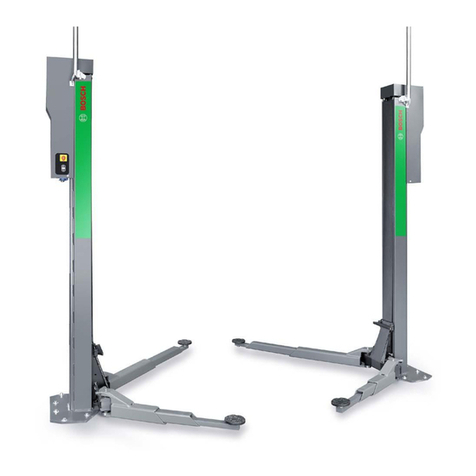
Bosch
Bosch VLE 21 Series Setup guide
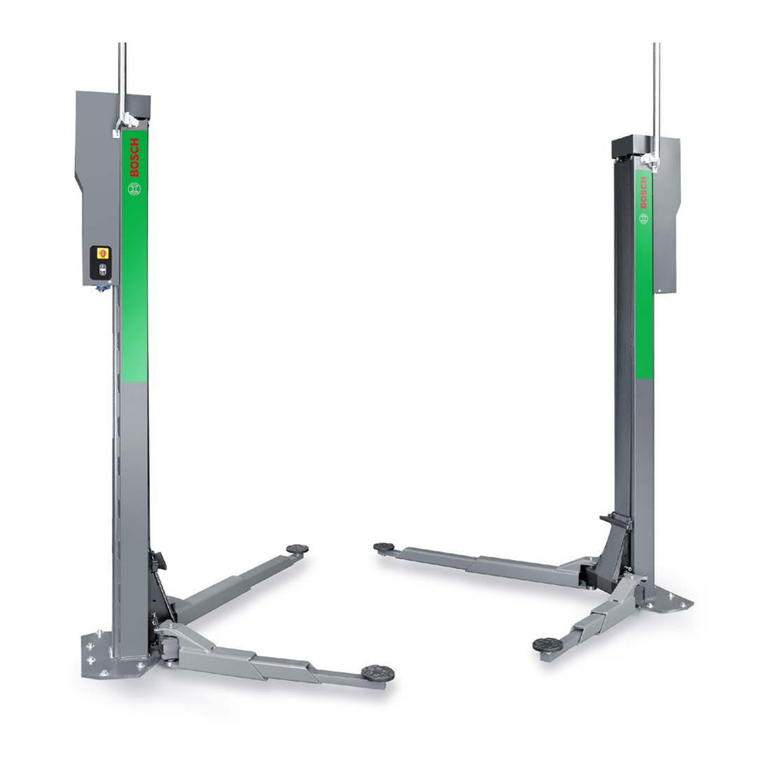
Bosch
Bosch VLE 2130 EL Manual

Bosch
Bosch 3448 User manual

Bosch
Bosch VLH 2235 User manual
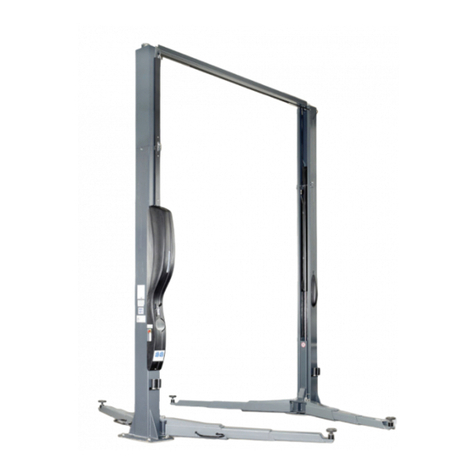
Bosch
Bosch VLH 2155 User manual
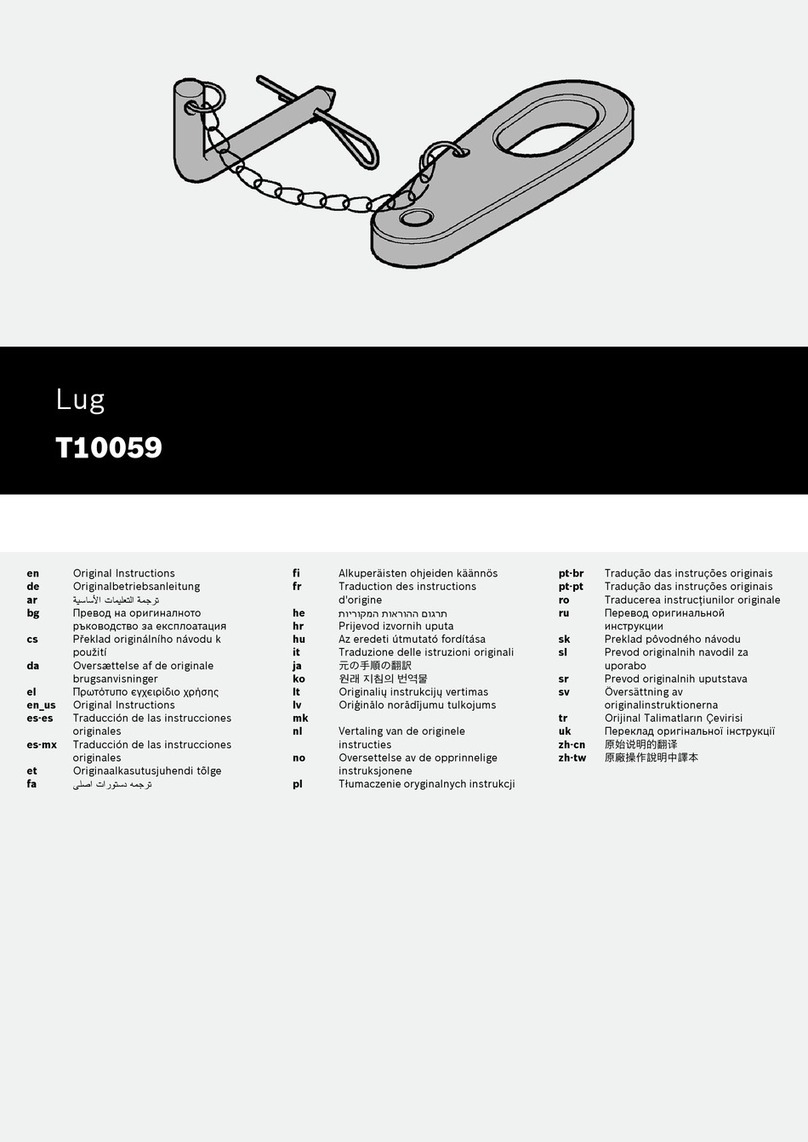
Bosch
Bosch T10059 User manual
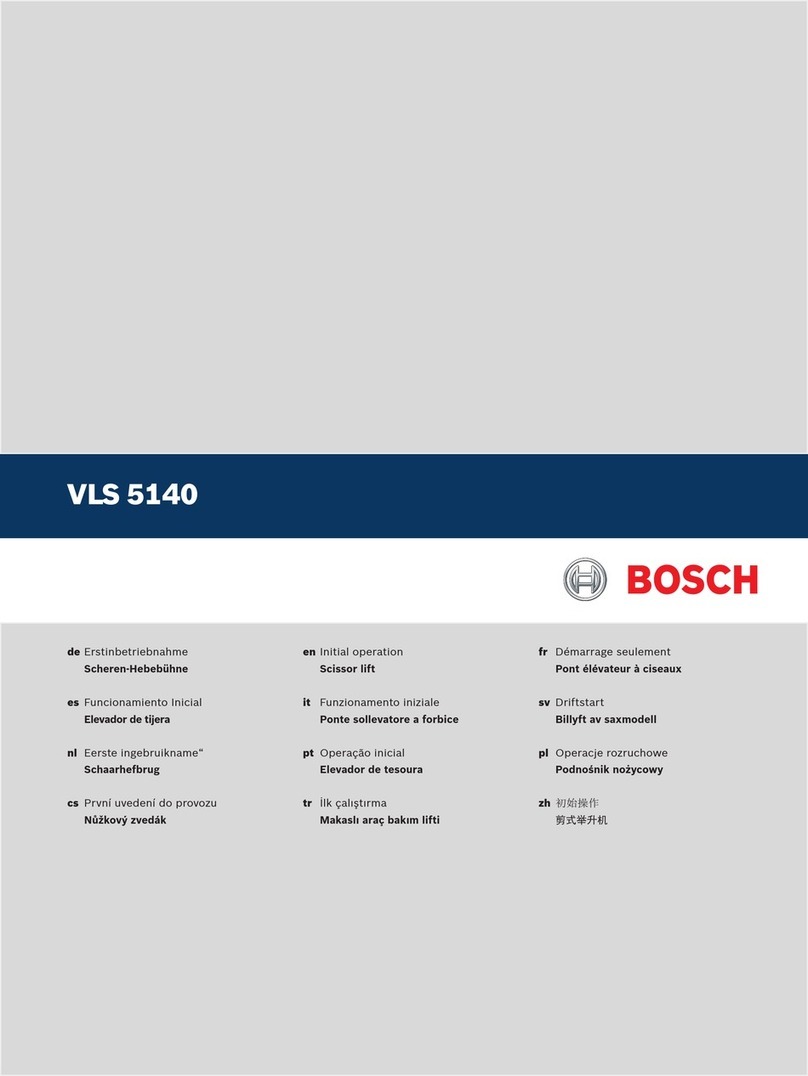
Bosch
Bosch VLS 5140 User manual
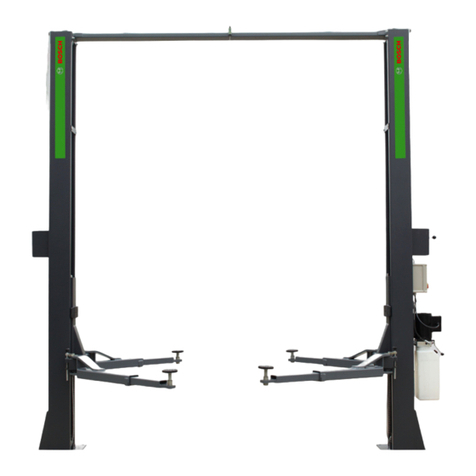
Bosch
Bosch VLH 2235H User manual

Bosch
Bosch Rexroth HQ 5/H User manual

Bosch
Bosch EL-53080 User manual
